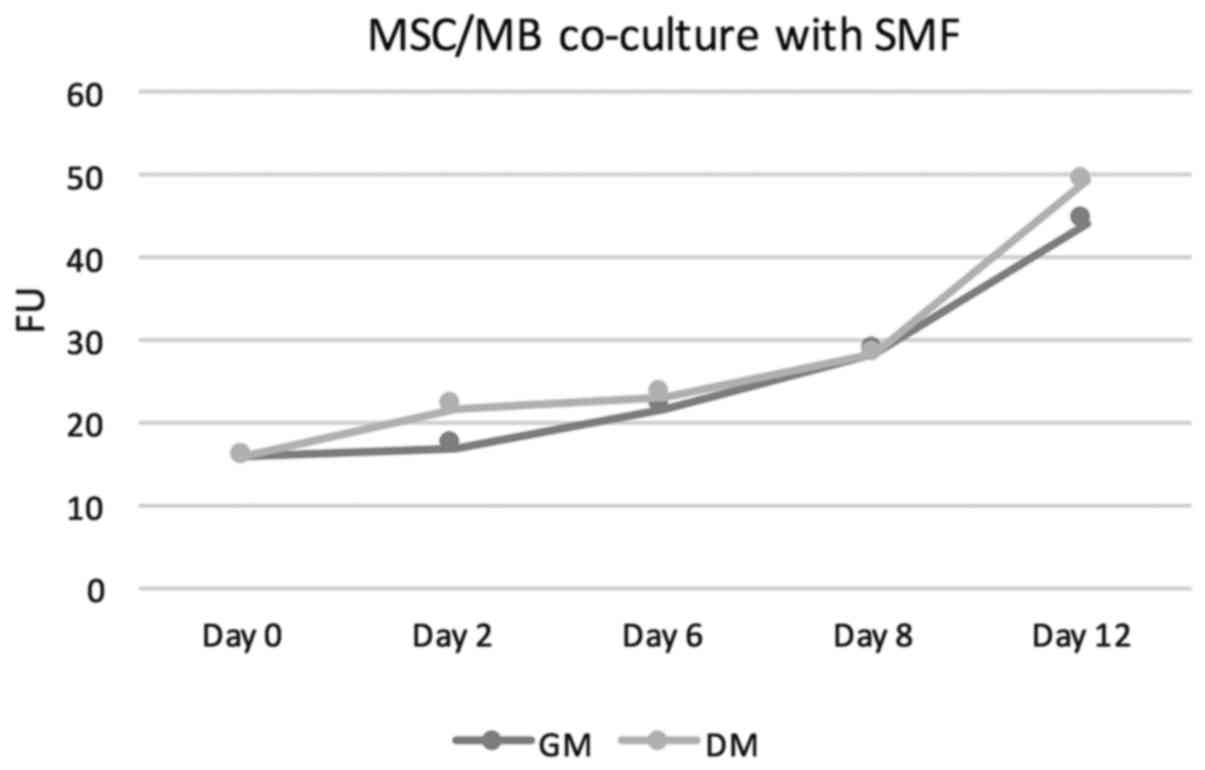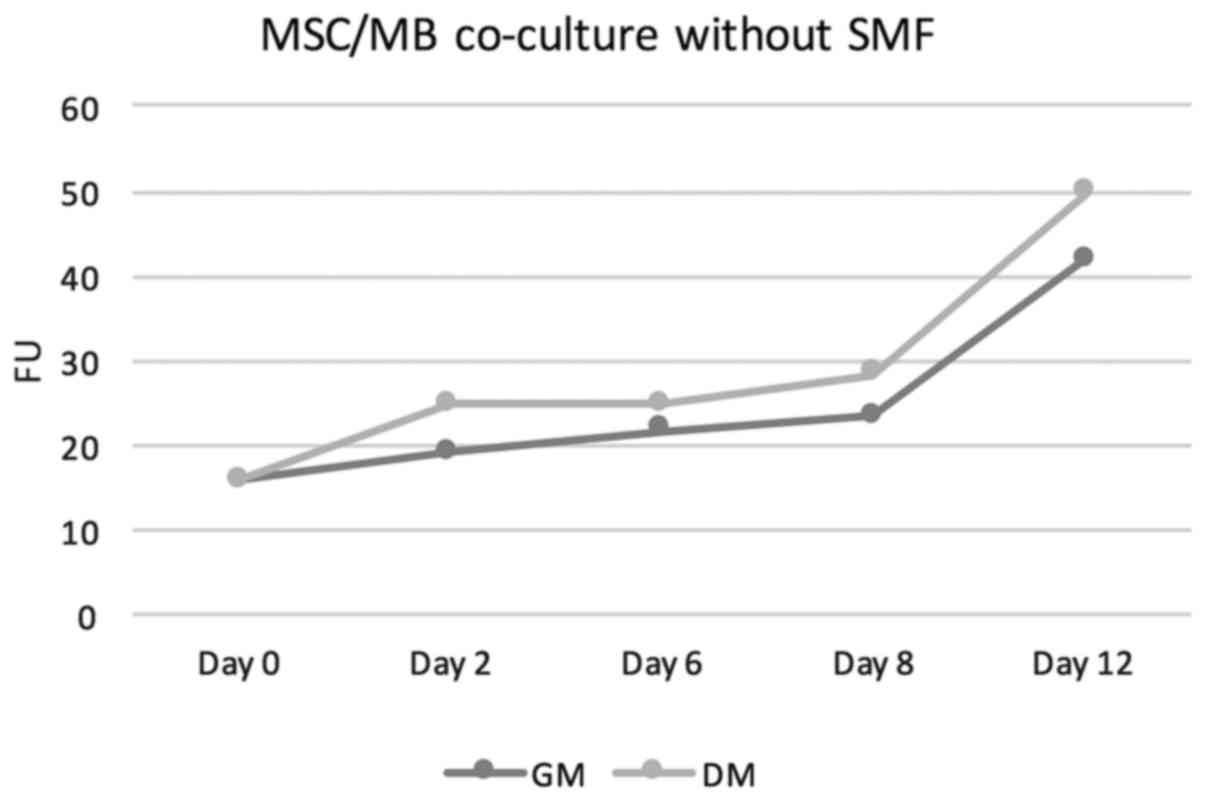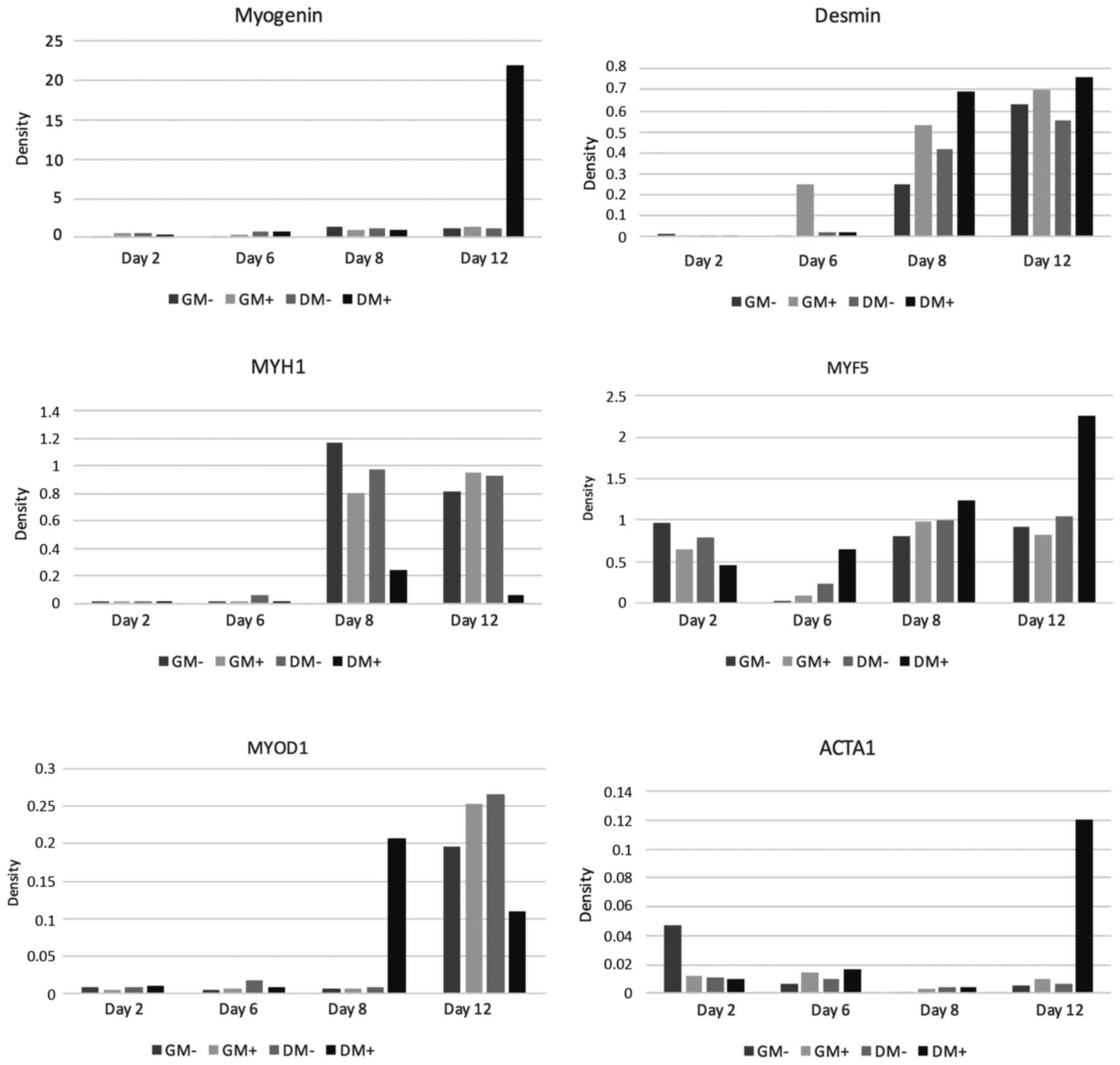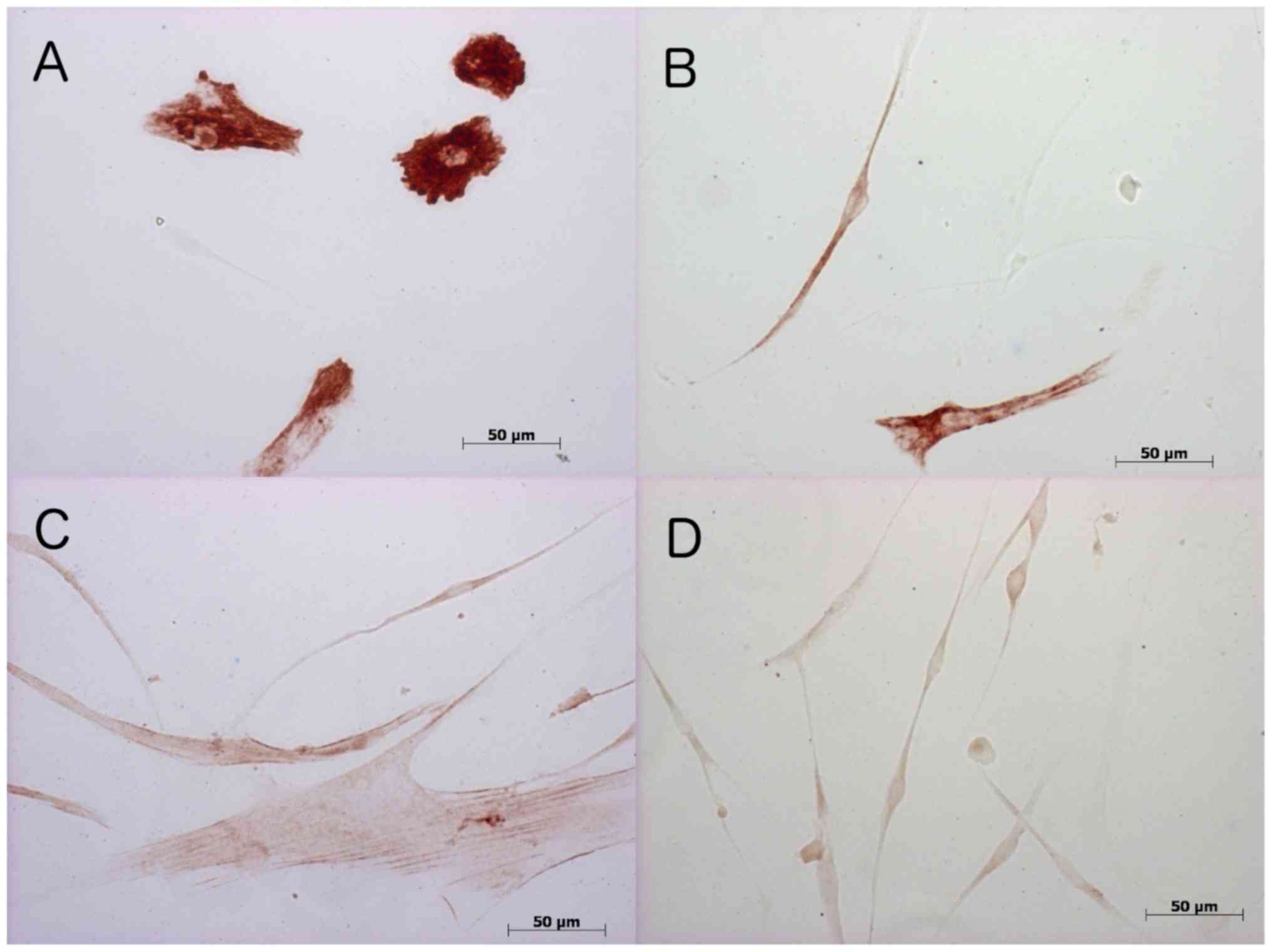|
1
|
Stern-Straeter J and Hörmann K: New
perspectives in skeletal muscle tissue engineering. HNO.
62:415–422. 2014.(In German). View Article : Google Scholar : PubMed/NCBI
|
|
2
|
Stern-Straeter J, Riedel F, Bran G,
Hörmann K and Goessler UR: Advances in skeletal muscle tissue
engineering. In Vivo. 21:435–444. 2007.PubMed/NCBI
|
|
3
|
Beier JP, Bitto FF, Lange C, Klumpp D,
Arkudas A, Bleiziffer O, Boos AM, Horch RE and Kneser U: Myogenic
differentiation of mesenchymal stem cells co-cultured with primary
myoblasts. Cell Biol Int. 35:397–406. 2011. View Article : Google Scholar : PubMed/NCBI
|
|
4
|
Coletti D, Teodori L, Albertini MC, Rocchi
M, Pristerà A, Fini M, Molinaro M and Adamo S: Static magnetic
fields enhance skeletal muscle differentiation in vitro by
improving myoblast alignment. Cytometry A. 71:846–856. 2007.
View Article : Google Scholar : PubMed/NCBI
|
|
5
|
Ferrari G, Cusella-De Angelis G, Coletta
M, Paolucci E, Stornaiuolo A, Cossu G and Mavilio F: Muscle
regeneration by bone marrow-derived myogenic progenitors. Science.
279:1528–1530. 1998. View Article : Google Scholar : PubMed/NCBI
|
|
6
|
Garcia-Castro J, Trigueros C, Madrenas J,
Pérez-Simón JA, Rodriguez R and Menendez P: Mesenchymal stem cells
and their use as cell replacement therapy and disease modelling
tool. J Cell Mol Med. 12:2552–2565. 2008. View Article : Google Scholar : PubMed/NCBI
|
|
7
|
Pittenger MF and Martin BJ: Mesenchymal
stem cells and their potential as cardiac therapeutics. Circ Res.
95:9–20. 2004. View Article : Google Scholar : PubMed/NCBI
|
|
8
|
Sassoli C, Pini A, Chellini F, Mazzanti B,
Nistri S, Nosi D, Saccardi R, Quercioli F, Zecchi-Orlandini S and
Formigli L: Bone marrow mesenchymal stromal cells stimulate
skeletal myoblast proliferation through the paracrine release of
VEGF. PLoS One. 7:e375122012. View Article : Google Scholar : PubMed/NCBI
|
|
9
|
Eldashev IS, Shchegolev BF, Surma SV and
Belostotskaia GB: Effect of low-intensity magnetic fields on the
development of satellite muscle cells of a newborn rat in the
primary culture. Biofizika. 55:868–874. 2010.(In Russian).
PubMed/NCBI
|
|
10
|
Sakurai T, Hashimoto A, Kiyokawa T,
Kikuchi K and Miyakoshi J: Myotube orientation using strong static
magnetic fields. Bioelectromagnetics. 33:421–427. 2012. View Article : Google Scholar : PubMed/NCBI
|
|
11
|
Stern-Straeter J, Bonaterra GA, Kassner
SS, Faber A, Sauter A, Schulz JD, Hörmann K, Kinscherf R and
Goessler UR: Impact of static magnetic fields on human myoblast
cell cultures. Int J Mol Med. 28:907–917. 2011.PubMed/NCBI
|
|
12
|
Birk R, Sommer U, Faber A, Aderhold C,
Schulz JD, Hörmann K, Goessler UR and Stern-Straeter J: Evaluation
of the effect of static magnetic fields combined with human
hepatocyte growth factor on human satellite cell cultures. Mol Med
Rep. 9:2328–2334. 2014. View Article : Google Scholar : PubMed/NCBI
|
|
13
|
Birk R, Sommer JU, Haas D, Faber A,
Aderhold C, Schultz JD, Hoermann K and Stern-Straeter J: Influence
of static magnetic fields combined with human insulin-like growth
factor 1 on human satellite cell cultures. In Vivo. 28:795–802.
2014.PubMed/NCBI
|
|
14
|
Christ B and Brand-Saberi B: Limb muscle
development. Int J Dev Biol. 46:905–914. 2002.PubMed/NCBI
|
|
15
|
Brand-Saberi B: Genetic and epigenetic
control of skeletal muscle development. Ann Anat. 187:199–207.
2005. View Article : Google Scholar : PubMed/NCBI
|
|
16
|
Ridgeway AG, Petropoulos H, Wilton S and
Skerjanc IS: Wnt signaling regulates the function of MyoD and
myogenin. J Biol Chem. 275:32398–32405. 2000. View Article : Google Scholar : PubMed/NCBI
|
|
17
|
Pette D and Staron RS: Myosin isoforms,
muscle fiber types, and transitions. Microsc Res Tech. 50:500–509.
2000. View Article : Google Scholar : PubMed/NCBI
|
|
18
|
Stern-Straeter J, Bonaterra GA, Juritz S,
Birk R, Goessler UR, Bieback K, Bugert P, Schultz J, Hörmann K,
Kinscherf R and Faber A: Evaluation of the effects of different
culture media on the myogenic differentiation potential of adipose
tissue- or bone marrow-derived human mesenchymal stem cells. Int J
Mol Med. 33:160–170. 2014. View Article : Google Scholar : PubMed/NCBI
|
|
19
|
Stern-Straeter J, Bran G, Riedel F, Sauter
A, Hörmann K and Goessler UR: Characterization of human myoblast
cultures for tissue engineering. Int J Mol Med. 21:49–56.
2008.PubMed/NCBI
|
|
20
|
Carlson ME and Conboy IM: Loss of stem
cell regenerative capacity within aged niches. Aging Cell.
6:371–382. 2007. View Article : Google Scholar : PubMed/NCBI
|
|
21
|
Pietrangelo T, Puglielli C, Mancinelli R,
Beccafico S, Fanò G and Fulle S: Molecular basis of the myogenic
profile of aged human skeletal muscle satellite cells during
differentiation. Exp Gerontol. 44:523–531. 2009. View Article : Google Scholar : PubMed/NCBI
|
|
22
|
Dezawa M, Ishikawa H, Itokazu Y, Yoshihara
T, Hoshino M, Takeda S, Ide C and Nabeshima Y: Bone marrow stromal
cells generate muscle cells and repair muscle degeneration.
Science. 309:314–317. 2005. View Article : Google Scholar : PubMed/NCBI
|
|
23
|
Corti S, Strazzer S, Del Bo R, Salani S,
Bossolasco P, Fortunato F, Locatelli F, Soligo D, Moggio M, Ciscato
P, et al: A subpopulation of murine bone marrow cells fully
differentiates along the myogenic pathway and participates in
muscle repair in the mdx dystrophic mouse. Exp Cell Res. 277:74–85.
2002. View Article : Google Scholar : PubMed/NCBI
|
|
24
|
de la Garza-Rodea AS, van der Velde-van
Dijke I, Boersma H, Gonçalves MA, van Bekkum DW, de Vries AA and
Knaän-Shanzer S: Myogenic properties of human mesenchymal stem
cells derived from three different sources. Cell Transplant.
21:153–173. 2012. View Article : Google Scholar : PubMed/NCBI
|
|
25
|
LaBarge MA and Blau HM: Biological
progression from adult bone marrow to mononucleate muscle stem cell
to multinucleate muscle fiber in response to injury. Cell.
111:589–601. 2002. View Article : Google Scholar : PubMed/NCBI
|
|
26
|
Di Rocco G, Iachininoto MG, Tritarelli A,
Straino S, Zacheo A, Germani A, Crea F and Capogrossi MC: Myogenic
potential of adipose-tissue-derived cells. J Cell Sci.
119:2945–2952. 2006. View Article : Google Scholar : PubMed/NCBI
|
|
27
|
Allen RE, Rankin LL, Greene EA, Boxhorn
LK, Johnson SE, Taylor RG and Pierce PR: Desmin is present in
proliferating rat muscle satellite cells but not in bovine muscle
satellite cells. J Cell Physiol. 149:525–535. 1991. View Article : Google Scholar : PubMed/NCBI
|













